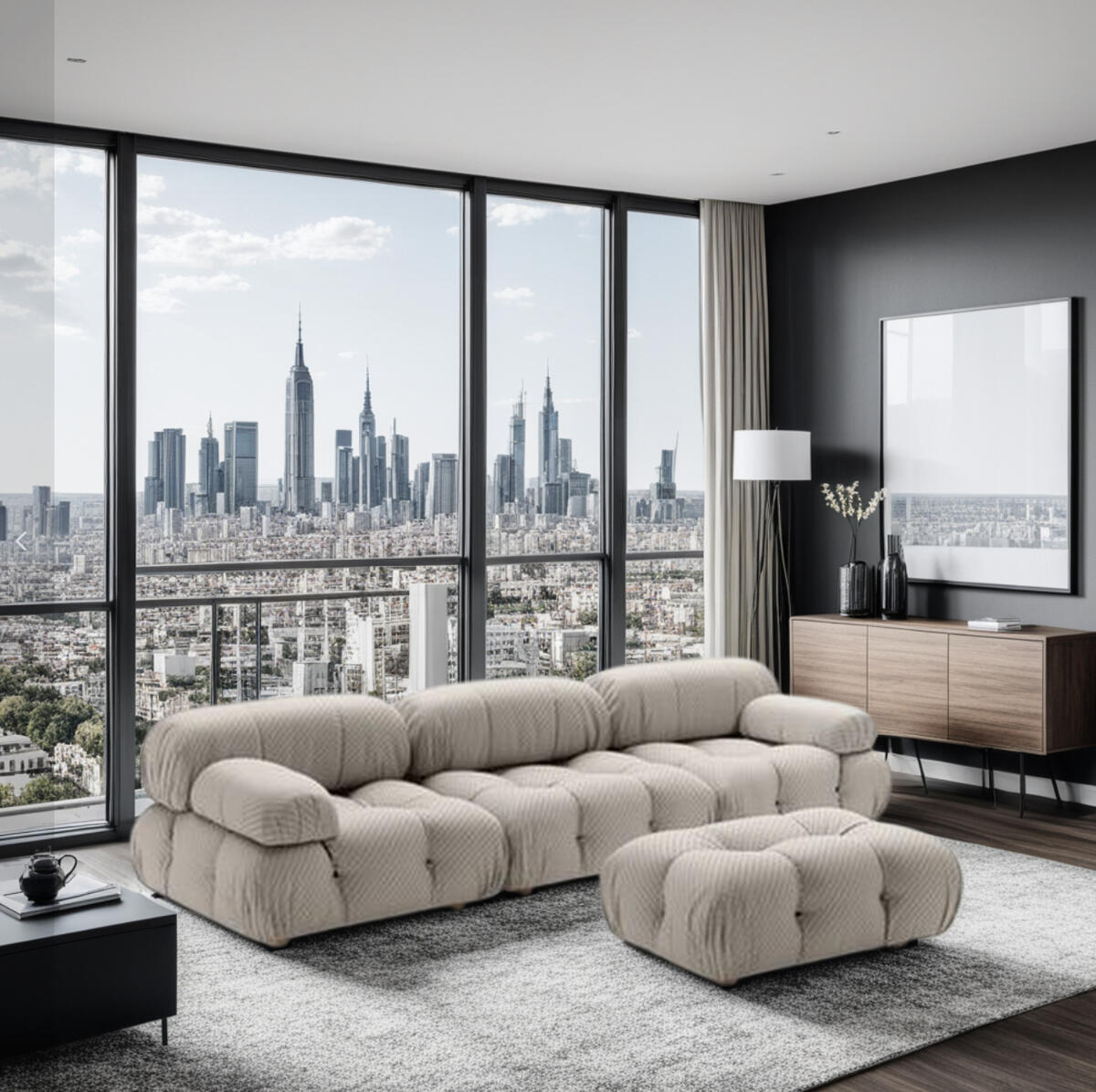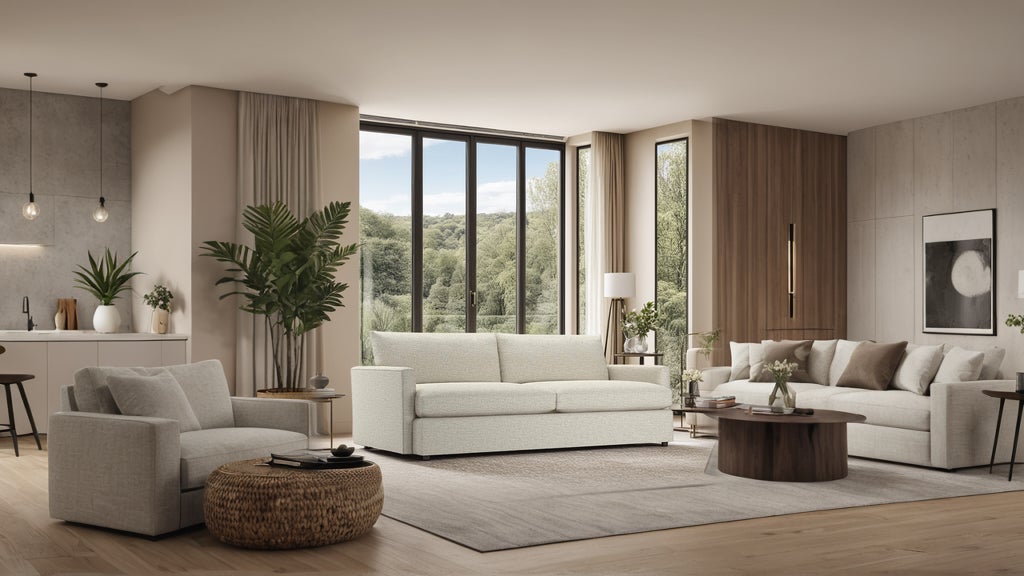For the past 10 years, the design industry has been learning not to trust its own eyes. As renderings have gotten increasingly realistic, it’s no longer possible—or at least easy—to tell the difference between a painstakingly styled interior and a painstakingly edited digital file. However, at the very least, one could assume it was a human who had taken the trouble to add dappled light to the fake room in question. No longer. A new Paris-based startup, Presti, has developed a tool that drops real product imagery into a room made entirely by AI. The site, which debuted in February, already claims more than 150 brands as clients.
“We were interested in AI, and we started brainstorming, and that led us to product photography and staging,” says Hamza Bennis, a co-founder of Presti. “Furniture companies were some of our first customers. They were begging us to develop what we were doing at the time; even though it wasn’t working well at first, they were very patient—that’s how we realized it’s such a pain point in the industry.”
Using artificial intelligence to create an image of a room is nothing new. As soon as engines like Dall-E and Midjourney debuted, people began using them to generate fanciful interiors. Soon after, a swarm of tools hit the marketplace offering “AI-powered interior design.”
These programs all suffered from similar problems. One is that they struggled to accurately re-create the envelope of an existing room. Another is that they could not make fine-tuned changes (“I want the same thing, but red pillows instead of blue”). Finally, their AI-generated creations did not feature actual product, but algorithmically approximated versions of the real thing. Even if you liked what they showed you, there was no click-to-buy.
Presti’s innovation is to hack its way around that last dilemma by starting with a product. Users—in this case, manufacturers, importers or retailers—upload an image of one of their pieces. They’re then asked to prompt Presti’s AI engine with some inspirational text (or an image) along the lines of “chic modern apartment, gorgeous view.” After whirring for a little, Presti spits out an image that features the product in a pied-à-terre overlooking an AI-dreamt-up version of Central Park.

The appeal of a tool like Presti is obvious for the makers, marketers and sellers of furniture. It is extremely expensive and time-consuming to make a sofa, ship it to a beautiful home, and pay a photographer to capture it. If one produces many different kinds of sofas, that cost only goes up. It’s not hard to see why many brands have explored digital renderings over the past decade—for them, experimenting with AI simply represents the next step in efficiency and cost-cutting. A single photograph taken by a professional photographer could cost tens of thousands of dollars. A renderer can do the same for a few hundred. Presti’s packages—sold on a monthly subscription basis—can level out to $10 per image.
AI is faster and cheaper than a human; it also makes mistakes that a human never would. Presti suffers from some of the same “hallucination” problems that plague AI-powered tools in general. I uploaded a silhouetted image of B&B Italia’s now-iconic Camaleonda sofa to test out the software, and in one iteration, Presti gave the famously low-slung piece a set of brass legs it very much does not have. I prompted the software to generate a “city view,” and it gave me a skyline with what appeared to be two or three Empire State Buildings. It is also possible to “tease” the algorithm with ridiculous suggestions: I asked for a Camaleonda surrounded by a coven of witches, and Presti dutifully obliged.
But despite the occasional flub or oddity, I was mostly surprised by how much Presti feels like a real software product, as opposed to a novelty or AI gold rush cash grab. With only a little patience and tweaking, it can absolutely generate a plausible marketing image for a sofa. A suite of features—like the ability to regenerate the lighting for an image; a “magic eraser” for unwanted details; scaling tools; and a “color swap” for different SKUs of the same frame—seem attuned to the real needs of furniture makers.
Presti, which has raised $3.5 million in seed funding since going through incubator Y Combinator’s boot camp, has quickly grown to a staff of 15. Its customer base includes U.S.-based companies like Phillips Collection and Wisteria, and in our conversation, Bennis’s co-founder Damir Babacic name-dropped Bernhardt.
Bennis and Babacic teased improvements that would soon make their software’s creation more and more indistinguishable from a professionally taken photo. At this stage, it’s hard to know exactly what to make of that claim. The images certainly are impressive—good enough for e-commerce in the right context. But it’s difficult to imagine them on the cover of an RH catalog. Even at a higher resolution, they suffer from the same challenge that all AI-generated images do—as algorithmically generated averages of other pictures, they have a kind of sameness that’s difficult to define but hard to shake.
That doesn’t necessarily limit Presti’s commercial potential. Most images of furniture—online and in print—aren’t artful hero shots, but workmanlike creations designed to contextualize a piece for shoppers and not much else. If they can be made for $10 as opposed to $100 or $1,000, many brands will find it compelling to hop on the AI train—but celebrity interior photographers like Douglas Friedman will still find work.
“I don’t think it’s going to be all AI or all non-AI,” says Babacic. “If you have a big banner on the front page of your website, obviously you want it to be the most unique and the best photo you can get. Once you get very, very deep in all the product pages, maybe you’ll get 10 hits a month on these products, and you don’t want to spend that much time on [them]. There, AI really becomes a use case.”





























